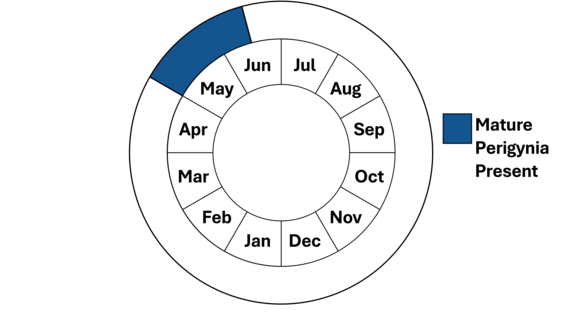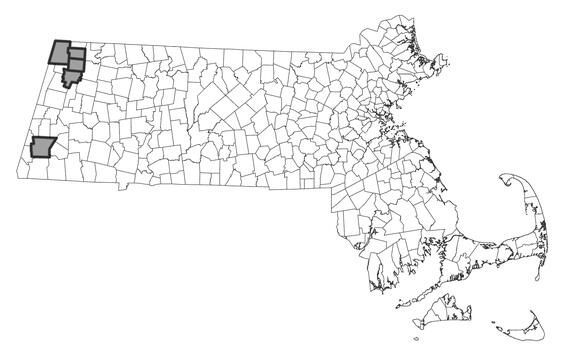- Scientific name: Carex trichocarpa
- Species of Greatest Conservation Need (MA State Wildlife Action Plan)
- Special Concern (MA Endangered Species Act)
Description
Hairy-fruited sedge, Carex trichocarpa, is a slender, dark blue-green, grass-like plant in the sedge family (Cyperaceae). This tall, fairly robust sedge grows in loose clumps from 6 -12 dm (1 3/4-4 1/4 ft) in height. The principal leaves are 4-8 mm (0.16-0.32 in) wide and have hairless sheaths (the lowermost, stem-enveloping portions of the leaves).Each sheath is marked by a red stripe at its top opposite the leaf. Hairy-fruited sedge generally has three male, or staminate, spikes and from two to four female, or pistillate, spikes (clusters of stalkless flowers.) Leaf-like bracts grow out from under these spikes and overtop them. The light brown scales (small, dry, scale-like structures) of the pistillate flowers are marked with light green down the middle and are about one-half as long to as long as the sac-like structures, known as perigynia, that enclose the female reproductive parts. The 6-10 mm (0.24-0.4 in) long, hairy perigynia are topped by a short, hairy beak (slender protuberance). Hairy-fruited sedge's fruits mature from early June through early July.
Both Schweinitz's sedge (Carex schweinitzii, endangered) and retrorse sedge (C. retrorsa, watch list) have been found growing with hairy-fruited sedge in Massachusetts. However, unlike hairy-fruited sedge, retrorse sedge has hairless perigynia. Schweinitz's sedge is generally much shorter than hairy-fruited sedge, growing only to 0.7 m (2 1/3 ft).

Population status
Hairy-fruited sedge is listed as special concern in Massachusetts. Hairy-fruited sedge is known from 9 populations verified since 1999 in Berkshire county. Two additional populations have not been observed recently.
Distribution and abundance
The documented range of hairy-fruited sedge extends Quebec south to North Carolina and west to Ontario and Minnesota. It extends south to Missouri and Tennessee. It is considered rare or of concern in most states where it occurs except in the middle of its range. In New England, it is critically imperiled in New Hampshire, imperiled in Massachusetts, vulnerable in Connecticut and Vermont and not known from Maine or Rhode Island.

Distribution in Massachusetts
1999-2024
Based on records in the Natural Heritage Database
Habitat
In New England, hairy-fruited sedge occurs in calcareous meadows and swales, especially near rivers. Massachusetts habitats include the edges of floodplain forests and swamps, wet meadows, edges of marshes and ponds and marshy swales. All these habitats are adjacent to or near a river. Plant species associated with hairy-fruited sedge include silky dogwood (Cornus amomum), cattail (Typha latifolia), reed canary grass (Phalaris arundinacea), retrorse sedge (Carex retrorsa, watch list), and various other species of sedge (including Carex spp. and Eleocharis spp.). Schweinitz's sedge (Carex schweinitzii, endangered) is a rare Massachusetts plant associated with hairy-fruited sedge.
Healthy habitats are vital for supporting native wildlife and plants. Explore habitats and learn about conservation and restoration in Massachusetts.
Threats
Reasons for the plant’s rarity in Massachusetts include habitat destruction.
Contact
| Date published: | April 9, 2025 |
|---|